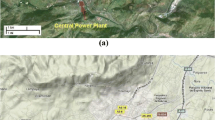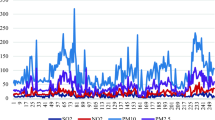Abstract
This study investigates the applicability of three different soft computing methods, least square support vector regression (LSSVR), multivariate adaptive regression splines (MARS), and M5 Model Tree (M5-Tree), in forecasting SO2 concentration. These models were applied to monthly data obtained from Janakpuri, Nizamuddin, and Shahzadabad, located in Delhi, India. The models were compared with each other using the cross validation method with respect to root mean square error, mean absolute error, and correlation coefficient. According to the comparison, LSSVR provided better accuracy than the other models, while the MARS model was found to be the second best model in forecasting monthly SO2 concentration. Results indicated that the applied models gave better forecasting accuracy in Janakpuri station than the other stations. The results were also compared with previous studies and satisfactory results were obtained from three methods in modeling SO2 concentrations.




Similar content being viewed by others
References
Akkoyunlu A, Yetilmezsoy K, Erturk F, Oztemel E (2010) A neural network-based approach for the prediction of urban SO2 concentrations in the Istanbul metropolitan area. Int J Environ Pollut 40(4):301–321
Andres JD, Lorca P, Juez FJ, Sánchez-Lasheras F (2010) Bankruptcy forecasting: a hybrid approach using Fuzzy c-means clustering and Multivariate Adaptive Regression Splines (MARS). Expert Syst Appl 38:1866–1875
Aneja VP, Agarwal A, Roelle PA, Phillips SB, Tong Q, Watkins N, Yablonsky R (2001) Measurements and analysis of criteria pollutants in New Delhi, India. Environ Int 27(1):35–42
Antanasijević DZ, Pocajt VV, Povrenović DS, Ristić MD, Perić-Grujić AA (2013) PM10 emission forecasting using artificial neural networks and genetic algorithm input variable optimization. Sci Total Environ 443:511–519
Bera P, Prasher SO, Patel RM, Madani A, Lacroix R, Gaynor JD, Tan SC, Kim SH (2006) Application of MARS in simulating pesticide concentrations in soil. Trans Am Soc Agric Eng 49:297–307
Corchado E, Herrero E (2011) Neural visualization of network traffic data for intrusion detection. Appl Soft Comput 11(2):2042–2056 CrossRef
Corchado E, Arroyo A, Tricio V (2011) Soft computing models to identify typical meteorological days. Logic J IGPL 19(2):373–383 MathSciNet CrossRef
Cortes C, Vapnik V (1995) Support vector networks. Mach Learn 20:273–297
Etemad-Shahidi A, Mahjoobi J (2009) Comparison between M5′ model tree and neural networks for prediction of significant wave height in Lake Superior. Ocean Eng 36:1175–1181. doi:10.1016/j.oceaneng.2009.08.008
EPA: Environmental Protection Agency Clean Air Interstate Rule. Accessed December 10, 2015a. (http://earthobservatory.nasa.gov/IOTD/view.php?id=87182)
EPA: Environmental Protection Agency Acid Rain Program. Accessed December 10, 2015b. (http://earthobservatory.nasa.gov/IOTD/view.php?id=82626)
Friedman JH (1991) Multivariate adaptive regression splines. Ann Stat 19:1–67
Ganguly D, Jayaraman A, Rajesh TA, Gadhavi H (2006) Wintertime aerosol properties during foggy and nonfoggy days over Urban Center Delhi and their implications for shortwave radiative forcing. J Geophys Res 111:D15217. doi:10.1029/2005JD007029
Gennaro G, Trizio L, Gilio A, Pey J, Pérez N, Cusack M, Alastuey A, Querol X (2013) Neural network model for the prediction of PM10 daily concentrations in two sites in the Western Mediterranean. Sci Total Environ 463-464:875–883
Goyal P (2003) Present scenario of air quality in Delhi: a case study of CNG implementation. Atmos Environ 37(38):5423–5431
Goyal MK, Bharti B, Quilty J, Adamowski J, Pandey A (2014) Modeling of daily pan evaporation in sub-tropical climates using ANN, LS-SVR, Fuzzy Logic, and ANFIS. Expert 516 Syst Appl 41(11):5267–5276
Gurjar BR, Van Aardenne JA, Lelieveld J, Mohan M (2004) Emission estimates and trends (1990–2000) for megacity Delhi and implications. Atmos Environ 38(33):5663–5681
Gurjar BR, Jain A, Sharma A, Agarwal A, Gupta P, Nagpure AS, Lelieveld J (2010) Human health risks in megacities due to air pollution. Atmos Environ 44(36):4606–4613
Guven A, Kisi O (2011) Daily pan evaporation modeling using linear genetic programming technique. Irrig Sci 29(2):135–145
Kim S, Shiri J, Kisi O (2012) Pan evaporation modeling using neural computing approach for different climatic zones. Water Resour Manag 26(11):3231–3249
Kim S, Shiri J, Singh VP, Kisi Ö, Landeras G (2015) Predicting daily pan evaporation by soft computing models with limited climatic data. Hydrol Sci J 60(6):1120–1136
Kisi O (2009a) Daily pan evaporation modelling using multi-layer perceptrons and radial basis neural networks. Hydrol Process 23(2):213–223
Kisi O (2009b) Fuzzy genetic approach for modeling reference evapotranspiration. J irrig 538 drainage eng 136(3):175–183
Kisi O (2015) Pan evaporation modeling using least square support vector machine, multivariate adaptive regression splines and M5 model tree. J Hydrol 528:312–320
Kisi O, Cengiz TM (2013) Fuzzy genetic approach for estimating reference evapotranspiration of Turkey: Mediterranean region. Water Resour Manag 27:3541–3553
Kisi, O and Parmar, K. S, 2016. Application of least square support vector machine and multivariate adaptive regression spline models in long term prediction of river water pollution. J Hydrology.
Kisi O, Tombul M (2013) Modeling monthly pan evaporations using fuzzy genetic approach. J Hydrol 477:203–212
Kisi O, Genc O, Dinc S, Zounemat-Kermani M (2016) Daily pan evaporation modeling using chi-squared automatic interaction detector, neural networks, classification and regression tree. Comput Elect Agr 122:112–117
Krotkov NA, McLinden CA, Li C, Lamsal LN, Celarier EA, Marchenko SV, Swartz WH, Bucsela EJ, Joiner J, Duncan BN, Boersma KF, Veefkind JP, Levelt PF, Fioletov VE, Dickerson RR, He H, Lu Z, Streets DG (2016) Aura OMI observations of regional SO2 and NO2 pollution changes from 2005 to 2015. Atmos Chem Phys 16:4605–4629. doi:10.5194/acp-16-4605-2016
Mitchell TM (1997) Machine learning. The McGraw-Hill Companies, Inc., New York 414
Mohan M, Kandya A (2007) An analysis of the annual and seasonal trends of air quality index of Delhi. Environ Monit Assess 131(1–3):267–277
Pal M, Deswal S (2009) M5 model tree based modelling of reference evapotranspiration. Hydrol Process 23:1437–1443
Parmar KS, Bhardwaj R (2014) River water prediction modeling using neural networks, fuzzy and wavelet coupled model. Water Resour Manage 29(1):17–33
Parmar KS, Soni K, Kumar N, Kapoor S (2016) Statistical variability comparison in MODIS and AERONET derived aerosol optical depth over Indo-Gangetic Plains using time series modeling. Sci Total Environ:553
Prasad AK, Singh S, Chauhan SS, Srivastava MK, Singh RP, Singh R (2007) Aerosol radiative forcing over the Indo-Gangetic Plains during major dust storms. Atmos Environ 41(6289–6301):2007
Quinlan JR (1992) Learning with continuous classes. In proceedings of the Fifth Australian Joint Conference on Artificial Intelligence, Hobart, Australia, 16–18 November. World Scientific, Singapore, pp 343–348
Rizwan SA, Nongkynrith B, Gupta SK (2013) Air pollution in Delhi: its magnitude and effects on health. Indian J Community Med 38:4–8 http://www.ijcm.org.in/text.asp?2013/38/1/4/106617
Sahin U, Ucan ON, Bayat C, Oztorun N (2005) Modeling of SO2 distribution in Istanbul using artificial neural networks. Environ Model Assess 10:135–142
Sahin UA, Ucan ON, Bayat C, Tolluoglu O (2011) A new approach to prediction of SO2 and PM10 concentrations in Istanbul, Turkey: cellular neural network (CNN). Environ Forensic 12(3):253–269
Seinfeld JH, Pandis SN (2006) Atmospheric chemistry and physics: from air pollution to climate change, vol 2006, 2nd edn. John Wiley & Sons, Hoboken
Sephton P (2001) Forecasting recessions: can we do better on MARS? Federal Reserve Bank of St. Louis Rev 83:39–49
Shafaei M, Kisi O (2016) Lake level forecasting using wavelet-SVR, wavelet-ANFIS and wavelet-ARMA conjunction models. Water Resour Manag 30(1):79–97. doi:10.1007/s11269-015-1147-z
Singh S, Nath S, Kohli R, Singh R (2005) Aerosols over Delhi during pre-monsoon months: characteristics and effects on surface radiation forcing. Geophys Res Lett 32:L13808
Singh S, Soni K, Bano T, Tanwar RS, Nath S, Arya BC (2010) Clear-sky direct aerosol radiative forcing variations over mega-city Delhi. Ann Geophys 28:1157–1166
Smola JA, Bernhard S (2004) A tutorial on support vector regression. Stat Comput 14:199–222
Solomatine DP, Xue Y (2004) M5 model trees compared to neural networks: application to flood forecasting in the upper reach of the Huai River in China. J Hydrol Eng 9:491–501
Soni K, Kapoor S, Parmar KS, Kaskaoutis DG (2014) Statistical analysis of aerosols over the Gangetic–Himalayan region using ARIMA model based on long-term MODIS observations. Atmos Res 149:174–119. doi:10.1016/j.atmosres.2014.05.025
Soni K, Parmar KS, Kapoor S (2015) Time series model prediction and trend variability of aerosol optical depth over coal mines in India. Environ Sci Pollut Res 22:3652–3671
Suykens JAK (2001) Support vector machines: a nonlinear modeling and control perspective. Eur J Control 7:311–327
Suykens JAK, Vandewalle J (1999) Least square support vector machine classifiers. Neural Process Lett 9:293–300
Vaidya V, Park JH, Arabnia HR, Pedrycz W, Peng S (2012) Bio-inspired computing for hybrid information technology. Soft Comput 16(3):367–368
Voukantsis D, Karatzas K, Kukkonen J, Räsänen T, Karppinen A, Kolehmainen M (2011) Intercomparison of air quality data using principal component analysis, and forecasting of PM10 and PM2.5 concentrations using artificial neural networks, in Thessaloniki and Helsinki. Sci Total Environ 409:1266–1276
Wanga P, Liu Y, Qin Z, Zhang G (2015) A novel hybrid forecasting model for PM10 and SO2 daily concentrations. Sci Total Environ 505:1202–1212
Acknowledgements
The authors are thankful to the Central Pollution Control Board (CPCB), Government of India, for providing the research data and Dr. B. R. Ambedkar National Institute of Technology, Jalandhar (Government of India) and IKG Punjab Technical University (Government of Punjab) for providing research facilities. The second author is also thankful to Prof. Rashmi Bhardwaj, Guru Gobind Singh Indraprastha University, for her motivation and astute guidance. The third author (KS) is grateful to the Director, CSIR-NPL.
Author information
Authors and Affiliations
Corresponding authors
Rights and permissions
About this article
Cite this article
Kisi, O., Parmar, K.S., Soni, K. et al. Modeling of air pollutants using least square support vector regression, multivariate adaptive regression spline, and M5 model tree models. Air Qual Atmos Health 10, 873–883 (2017). https://doi.org/10.1007/s11869-017-0477-9
Received:
Accepted:
Published:
Issue Date:
DOI: https://doi.org/10.1007/s11869-017-0477-9




